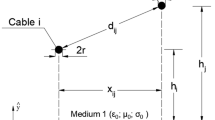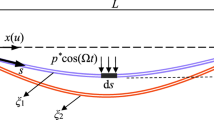Abstract
In this paper, a model of aerial multiconductor transmission lines with frequency-dependent electrical parameters for the simulation of time-domain electromagnetic transients due to incident electromagnetic fields is presented. The frequency dependency of the electrical parameters is taken into account using the penetration impedance; this allows applying the method of characteristics without having to resort to modal transformations. With this alternative approach, transforming the transmission line partial differential equations to ordinary differential equations is performed in the phase domain, which simplifies the mathematical development of the method and also the numerical solution. The validity of the proposed model is shown with five study cases involving different transmission systems and excitations.















Similar content being viewed by others
References
Taylor CD, Satterwhite RS, Harrison CW (1965) The response of a terminated two-wire transmission line excited by a nonuniform electromagnetic field. IEEE Trans Antennas Propag 13(6):987–989
Agrawal AK, Price HJ, Gurbaxani SH (1980) Transient response of multiconductor transmission lines excited by a nonuniform electromagnetic field. IEEE Trans Electromag Compat 22(2):119–129
Rachidi F (1993) Formulation of the field-to-transmission line coupling equations in terms of magnetic excitation fields. IEEE Trans Electromagn Compat 35(3):404–407
Rusck S (1958) Induced lightning overvoltages on power transmission lines with special reference to the overvoltage protection of low voltage networks. Trans R Inst Technol 120:1–118
Chowdhuri P, Gross ETB (1967) Voltage surges induced on overhead lines by lighting strokes. Proc IEE 114(12):1899–1907
Cooray V (1994) Calculating lightning-induced overvoltages in power lines: a comparison of two coupling models. IEEE Trans Electromagn Compat 36(3):179–182
Nucci CA, Rachidi F, Ianoz M, Mazzetti C (1995) Comparison of two coupling models for lightning-induced overvoltage calculations. IEEE Trans Power Deliv 10(1):330–339
Andreotti A, Pierno A, Rakov VA (2015) A new tool for calculation of lightning-induced voltages in power systems—part I: development of circuit model. IEEE Trans Power Deliv 30(1):326–333
Liu X, Cui X, Qi L (2012) Calculation of lightning-induced over voltages on overhead lines based on DEPACT macromodel using circuit simulation software. IEEE Trans Electromagn Compat 54(4):837–849
Brignone M, Delfino F, Procopio R, Rossi M, Rachidi F (2017) Evaluation of power system lightning performance, part I—model and numerical solution using the PSCAD-EMTDC platform. IEEE Trans Electromagn Compat 59(1):137–145
Abouzeid SI, Shabib G, El Dein Mohamed AZ (2015) Induced voltages on overhead transmission lines because of nearby included lightning channel. IET Gener Transm Distrib 9(13):1672–1680
Tan EL, Yang Z (2017) Non-uniform time-step FLOD-FDTD method for multiconductor transmission lines including lumped elements. IEEE Trans Electromagn Compatib 59(6):1983–1992
Paolone M, Nucci CA, Rachidi F (2001) A new finite difference time domain scheme for the evaluation of lightning induced overvoltage on multiconductor overhead lines. In: Proceedings of international conference on power system transaction, pp 596–602
Ames WF (1992) Numerical methods for partial differential equations. Academic Press, San Diego
Ramirez A, Naredo JL, Moreno P (2005) Full frequency-dependent line model for electromagnetic transient simulation including lumped and distributed sources. IEEE Trans Power Deliv 20(1):292–299
Garcia-Sanchez JL, Moreno P et al (2016) Aerial line model for power system electromagnetic transients simulation. IET Gener Transm Distrib 10(7):1597–1604
Branin FH (1967) Transient analysis of lossless transmission lines. Proc IEEE 55(11):2012–2013
Martí JT (1982) Accurate modelling of frequency-dependent transmission lines in electromagnetic transient simulations. IEEE Trans Power Appar Syst 101(1):147–157
Morched A, Gustavsen B, Tartibi M (1999) A universal model for accurate calculation of electromagnetic transients on overhead lines and underground cables. IEEE Trans Power Deliv 14(3):1032–1038
Moreno P, Ramirez A (2008) Implementation of the numerical Laplace transform: a review. IEEE Trans Power Deliv 23(4):2599–2609
Nucci CA, Rachidi F, Ianoz MV (1993) Lightning-induced voltages on overhead lines. IEEE Trans Electromagn Compat 35(1):75–85
Barbosa CF, Saldanha JO (2007) An approximate time-domain formula for the calculation of the horizontal electric field from lightning. IEEE Trans Electromagn Compat 49(3):593–601
Acknowledgements
Mr. Avisaí Sánchez-Alegria thanks the scholarship granted by the Consejo Nacional de Ciencia y Tecnología (Grand No. CVU 569017) of México.
Author information
Authors and Affiliations
Corresponding author
Additional information
Publisher's Note
Springer Nature remains neutral with regard to jurisdictional claims in published maps and institutional affiliations.
Appendix
Appendix
In this Appendix, the recursive convolution algorithm based on the method of the auxiliary differential equation is revisited. Using (4) and (5b) can be expressed in the Laplace domain as follows
where
From (23b), it follows that
Transforming (24a, 27) to the time domain gives
The auxiliary differential Eq. (27) can be solved applying several finite-difference schemes; here, it is used the backward-difference formula; therefore, it can be written
Solving for Ψi(x,t) gives
Finally, using (29) expression (5b) becomes
Rights and permissions
About this article
Cite this article
Sánchez-Alegría, A., Moreno, P., Loo-Yau, J.R. et al. An alternative model for aerial multiconductor transmission lines excited by external electromagnetic fields based on the method of characteristics. Electr Eng 101, 719–731 (2019). https://doi.org/10.1007/s00202-019-00819-4
Received:
Accepted:
Published:
Issue Date:
DOI: https://doi.org/10.1007/s00202-019-00819-4




